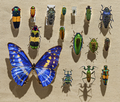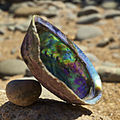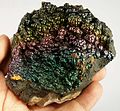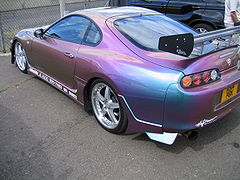Iridescence

Iridescence (also known as goniochromism) is the phenomenon of certain surfaces that appear
colour as the angle of view or the angle of illumination changes. Iridescence is caused by wave interference of light in microstructures or thin films. Examples of iridescence include soap bubbles, feathers, butterfly wings and seashell nacre, and minerals such as opal. Pearlescence
is a related effect where some or most of the reflected light is white. The term pearlescent is used to describe certain paint finishes, usually in the automotive industry, which actually produce iridescent effects.
Etymology
The word iridescence is derived in part from the
gen. ἴριδος íridos), meaning rainbow, and is combined with the Latin suffix -escent, meaning "having a tendency toward".[1] Iris in turn derives from the goddess Iris of Greek mythology, who is the personification of the rainbow
and acted as a messenger of the gods. Goniochromism is derived from the Greek words gonia, meaning "angle", and chroma, meaning "colour".
Mechanisms

Iridescence is an
interference of the reflections modulates the incidental light, by amplifying or attenuating some frequencies more than others.[2][4] The thickness of the layers of the material determines the interference pattern. Iridescence can for example be due to thin-film interference, the functional analogue of selective wavelength attenuation as seen with the Fabry–Pérot interferometer, and can be seen in oil films on water and soap bubbles. Iridescence is also found in plants, animals and many other items. The range of colours of natural iridescent objects can be narrow, for example shifting between two or three colours as the viewing angle changes,[5][6]

Iridescence can also be created by
In biological (and
peacock's feather was lost when it was plunged into water, but reappeared when it was returned to the air, pigments could not be responsible.[13][14] It was later found that iridescence in the peacock is due to a complex photonic crystal.[15]
Pearlescence
black-lip pearl oyster
Pearlescence is an effect related to iridescence and has a similar cause. Structures within a surface cause light to be reflected back, but in the case of pearlescence some or most of the light is white, giving the object a
car paints.[17]
Examples
Life
Invertebrates
Eledone moschata has a bluish iridescence running along its body and tentacles.[18]
-
Cornell drawer displaying iridescent insects
-
The iridescent exoskeleton of a golden stag beetle
-
Structurally coloured wings of Morpho didius
-
The inside surface of Haliotis iris, the paua shell
Vertebrates
The
Cnemaspis kolhapurensis, was identified in India in 2009.[22] The tapetum lucidum, present in the eyes of many vertebrates, is also iridescent.[23] Iridescence is known to be present among prehistoric non-avian and avian dinosaurs such as dromaeosaurids, enantiornithes, and lithornithids.[24]
-
Both the body and the train of the peacock are iridescent
-
The rainbow boa
Plants
Many groups of plants have developed iridescence as an adaptation to use more light in dark environments such as the lower levels of tropical forests. The leaves of Southeast Asia's
-
Iridescent Begonia leaf
-
Selaginella wildenowiileaves
-
Pollia condensata fruits
-
Ophrys speculum flowers
Non-biological
Minerals
-
Abismuth oxide, with a whitish-silver bismuth cube for comparison
-
Polished labradorite
Meteorological
-
Nacreousiridescence
Human-made
-
Pearlescent paintjob on a Toyota Supra car
-
Playing surface of a compact disc
-
Iridescent glitter nail polish
-
Smartphone with iridescent back panel
-
Anengine oilspill
See also
- Anisotropy
- Bioluminescence, irrespective of angle
- Dichroic filter
- Dichroism
- Iridocyte
- Labradorescence(Adularescence)
- Metallic colour
- Opalescence
- Structural colour
- Thin-film optics
- Nacre
- Opal
References
- ^ "Online Etymology Dictionary". etymonline.com. Archived from the original on 2014-04-07.
- ^ PMID 11849015.
- S2CID 53068819.
- PMID 19336343.
- ^ PMID 20554565.
- PMID 16191648.
- ISBN 978-1-284-03080-8.
- PMID 29273708.
- ISBN 978-0-226-47052-8.[page needed]
- PMID 24713039.
- PMID 25243861.
- S2CID 100181186.
- ^ Hooke, Robert. Micrographia. Chapter 36 ('Observ. XXXVI. Of Peacoks, Ducks, and Other Feathers of Changeable Colours.')
- PMID 22550931.)
{{cite journal}}: CS1 maint: DOI inactive as of February 2024 (link - ^ PMID 14557541.
- ISBN 978-0-89236-586-9.
- ^ Paint and Coating Testing Manual. ASTM International. pp. 229–. GGKEY:7W7C2G88G2J.
- ^ Mazza, Giuseppe (2008-08-07). "Eledone moschata". Monaco Nature Encyclopedia. Retrieved 2023-02-07.
- PMID 22071186.
- PMID 21159676.
- S2CID 4386607.
- ^ "New lizard species found in India". BBC Online. 24 July 2009. Retrieved 20 February 2014.
- ISBN 978-1-893441-69-9.
- PMID 32426504.
- PMID 20142263.
- JSTOR 2445040.
- PMID 22988816.
- ISBN 978-1-57859-357-6.
External links
Wikimedia Commons has media related to Iridescence.
- A 2.2 MB GIF animation of a morpho butterfly showing iridescence
- "Article on butterfly iridescence" Archived 2015-11-07 at the Wayback Machine






















